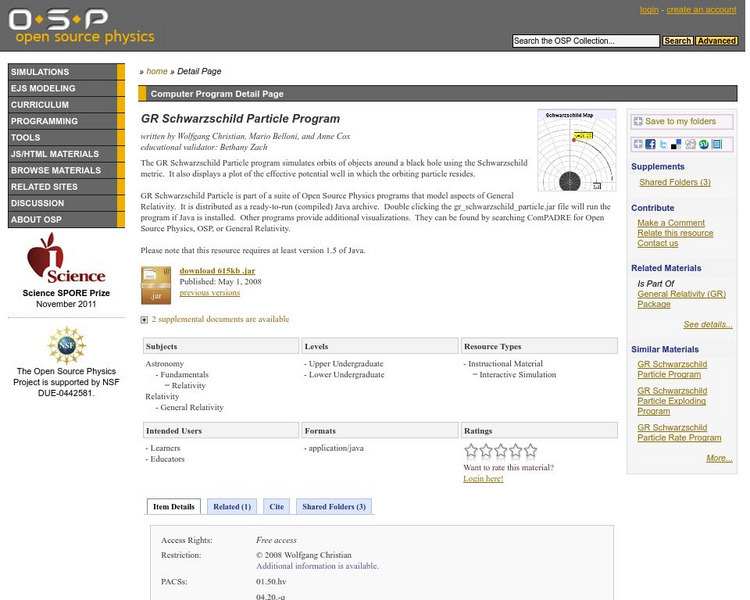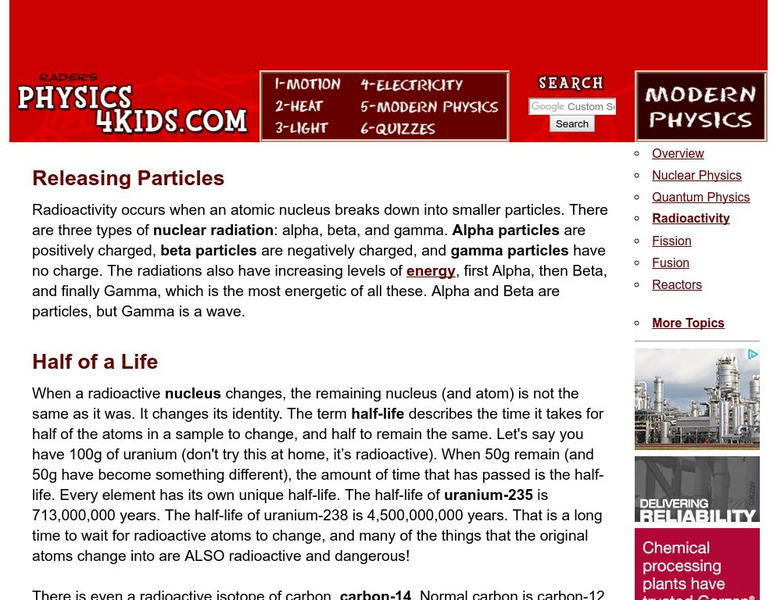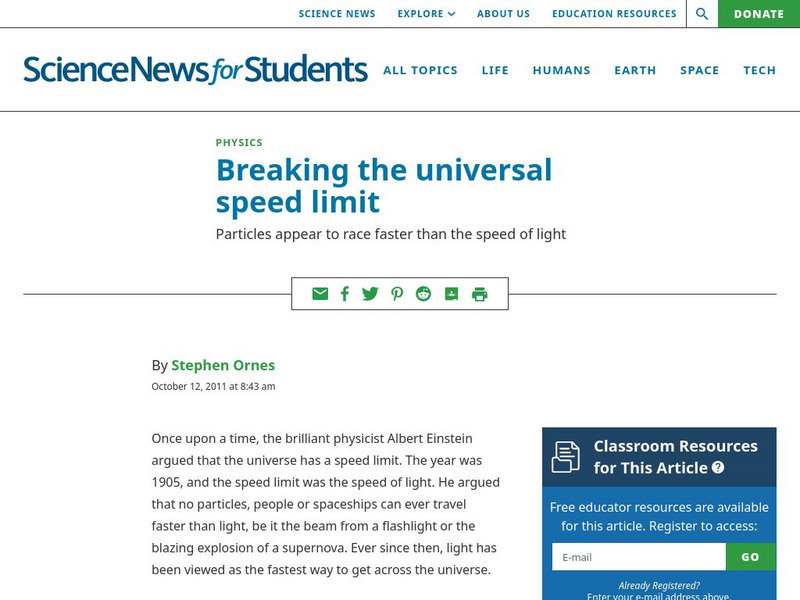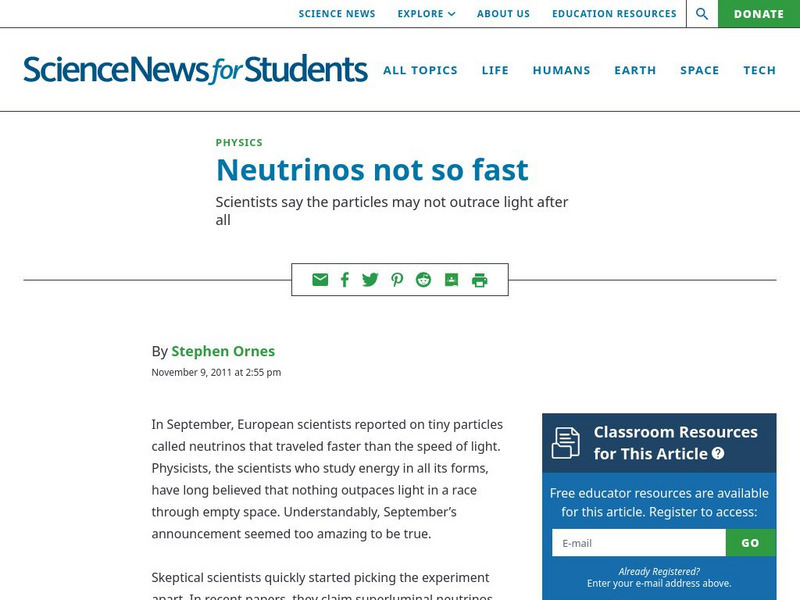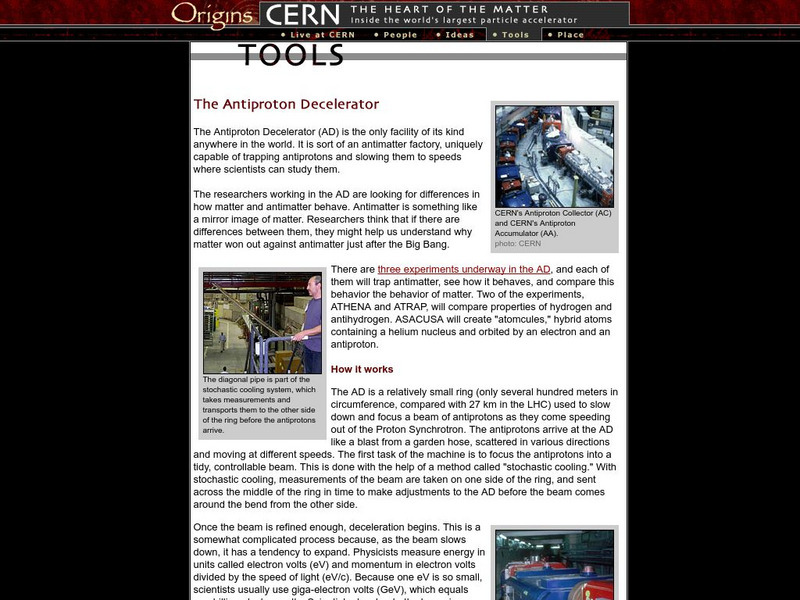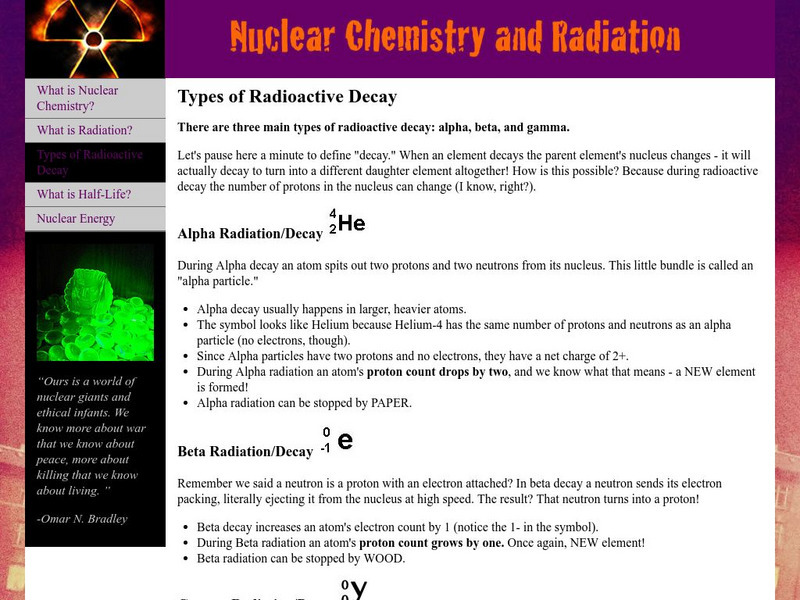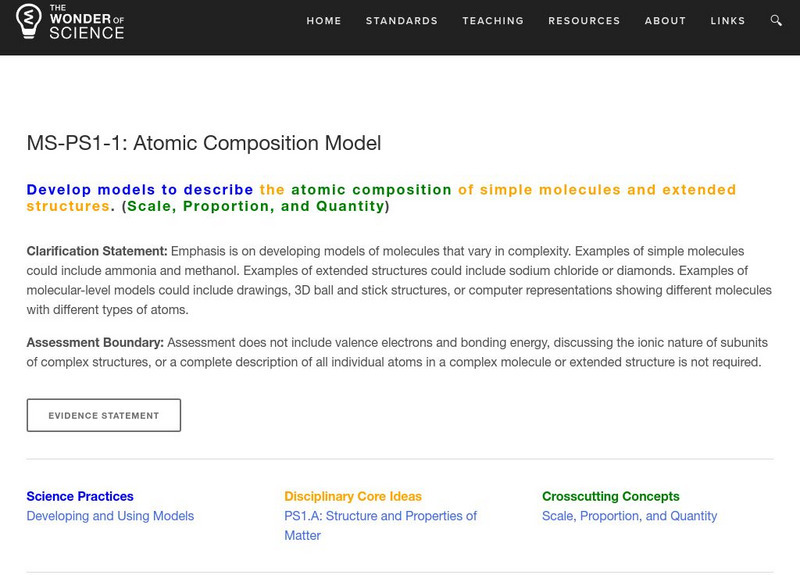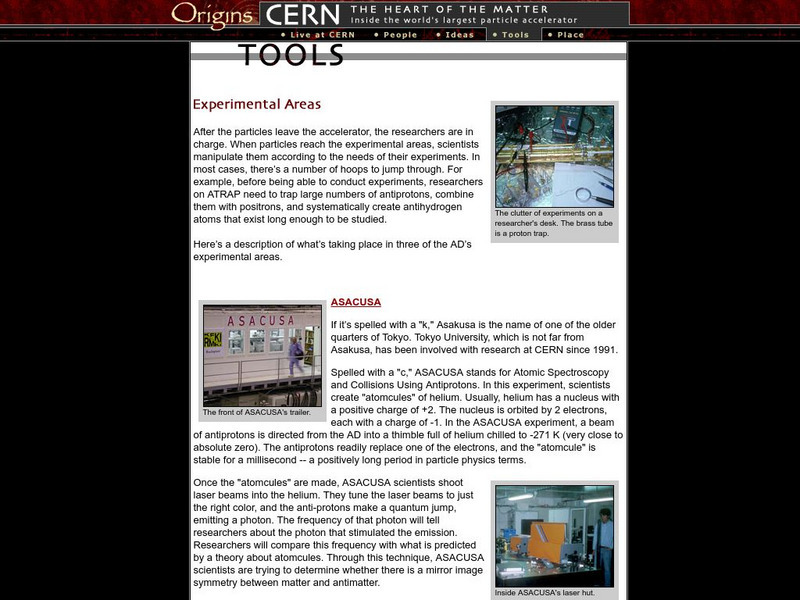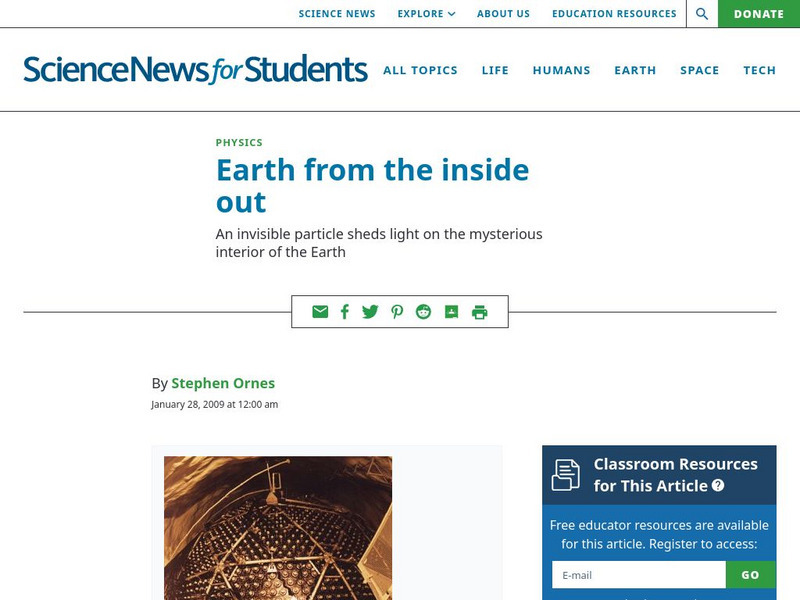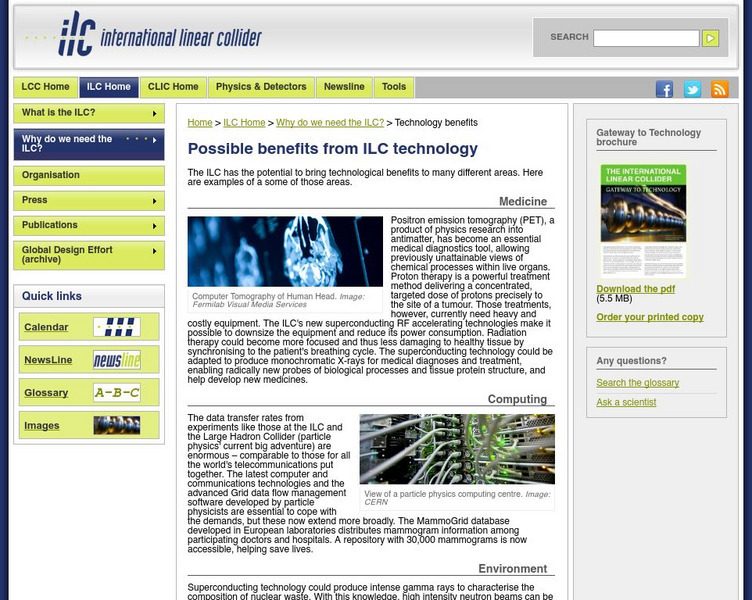ABCya
Ab Cya: Colorush
Colorush is a fun puzzle game for the whole family! Guide the color particle from the container to the capacitor. Different items will get introduced along the way to help you on your puzzle journey!
American Association of Physics Teachers
Com Padre Digital Library: Open Source Physics: Schwarzschild Particle Program
Visualization using the Schwarzschild metric, showing the behavior of an object as it orbits about a black hole.
Physics4kids
Physics4 Kids: Modern Physics: Releasing Particles
Explains basic information about radioactivity. Learn about half-life through text and video.
New York University
New York University: States of Water
Use this resource to learn about the three different phases of water; solid, liquid, and gas. What happens to water as it changes into a solid or gas? Includes short and easy to do activity.
Physics4kids
Physics4 Kids: Modern Physics: Looking at the Nucleus
Explains basic information about the nucleus of an atom.
Georgia State University
Georgia State University: Hyper Physics: Nuclear Fusion
This site from Georgia State University provides a lengthy page with a thorough description of the fusion process. Discussion is complemented by excellent graphics and links to further information.
Society for Science and the Public
Science News for Students: Breaking the Universal Speed Limit
Describes research into whether neutrinos travel faster than the speed of light.
Society for Science and the Public
Science News for Students: Neutrinos Not So Fast
Discusses the validity of research showing that neutrinos travel faster than the speed of light.
TED Talks
Ted: Ted Ed: The Basics of the Higgs Boson
Using the Socratic method, CERN scientists Dave Barney and Steve Goldfarb explain the exciting implications of the Higgs boson. [6:30]
Exploratorium
Exploratorium: Cern: The Antiproton Decelerator
Explains the function of the Antiproton Decelerator, a device at the European Center for Nuclear Research used to "slow down" bunches of antiprotons for use in experiments.
Boise State University
Boise State: Nuclear Chemistry and Radiation: Types of Radioactive Decay
This article with embedded videos provides information about three main types of radioactive decay: alpha, beta, and gamma.
The Wonder of Science
The Wonder of Science: Ms Ps1 1: Atomic Composition Model
A collection of lesson plans for helping middle schoolers understand atomic composition. Site uses work samples, phenomena, assessment templates, and videos to plan lessons to describe the atomic composition of simple molecules.
Exploratorium
Exploratorium: Cern: Experiments With Antimatter
A description of the two primary experiments conducted at CERN on antimatter: ASACUSA, an attempt to form "Atomcules," using antiprotons; and ATHENA, an experiment to compare the properties of hydrogen and antihydrogen.
Georgia State University
Georgia State University: Hyper Physics: Hadrons
This site defines hadrons and their characteristics. There are links to explanations and more detailed information about interactions and composition.
TED Talks
Ted: Ted Ed: Patricia Burchat Sheds Light on Dark Matter
Watch as physicist, Patricia Burchat, discusses two basic ingredients of our universe, dark matter and dark energy, and the effects they have in the expanding universe. [17:09]
Wikimedia
Wikipedia: Democritus
This encyclopedia entry surveys the life and thought of the 5th century BCE Greek philosopher Democritus, who proposed the existence of the atom.
Society for Science and the Public
Science News for Students: Earth From the Inside Out
Describes scientists attempts to use geoneutrinos to see 'inside' the Earth.
TED Talks
Ted: Ted Ed: The 2400 Year Search for the Atom
How do we know what matter is made of? The quest for the atom has been a long one, beginning 2,400 years ago with the work of a Greek philosopher and later continued by a Quaker and a few Nobel Prize-winning scientists. Theresa Doud...
TED Talks
Ted: Ted Ed: If Matter Falls Down, Does Antimatter Fall Up?
Chloe Malbrunot investigates matter and anti-matter by placing two atoms- one made of matter, and the other antimatter- in the cockpit of a plane, ready to jump. What do you think will happen? [2:54]
TED Talks
Ted: Ted Ed: What Happened to Antimatter?
CERN scientist Rolf Landua returns to the seconds after the Big Bang to explain the disparity that allows humans to exist today. [5:16]
Symmetry Magazine
Symmetry Magazine: Explain It in 60 Seconds: A Positron
Learn about positrons, an antiparticle and the opposite of an electron. Also available as a PDF, which requires Adobe Reader.
PBS
Science Odyssey: Heisenberg States Uncertainty Principle
Explains the Heisenberg Uncertainty Principle, that it is impossible to know both the momentum and position of an electron, along with describing the impact that it made upon the scientific community upon its introduction in 1927.
Other
International Linear Collider: Possible Benefits From Ilc Technology
Research with linear colliders may enormously benefit fields such as medicine, computing and the environment. Examples include medical proton therapy and the potential of being able to render nuclear waste harmless. A wonderful side...
Other
Greek Philosophy: Leucippus and Democritus
This article provides an overview of the atomistic philosophy of the pre-Socratic philosophers Leucippus and Democritus in the 5th and 4th centuries, BCE.

